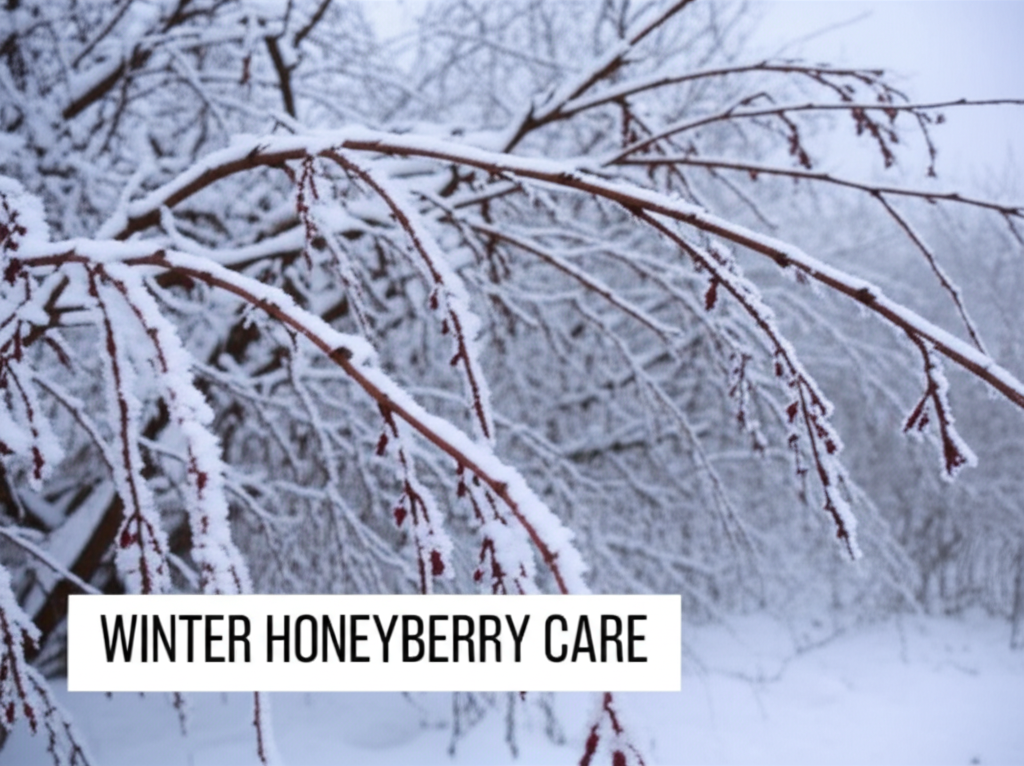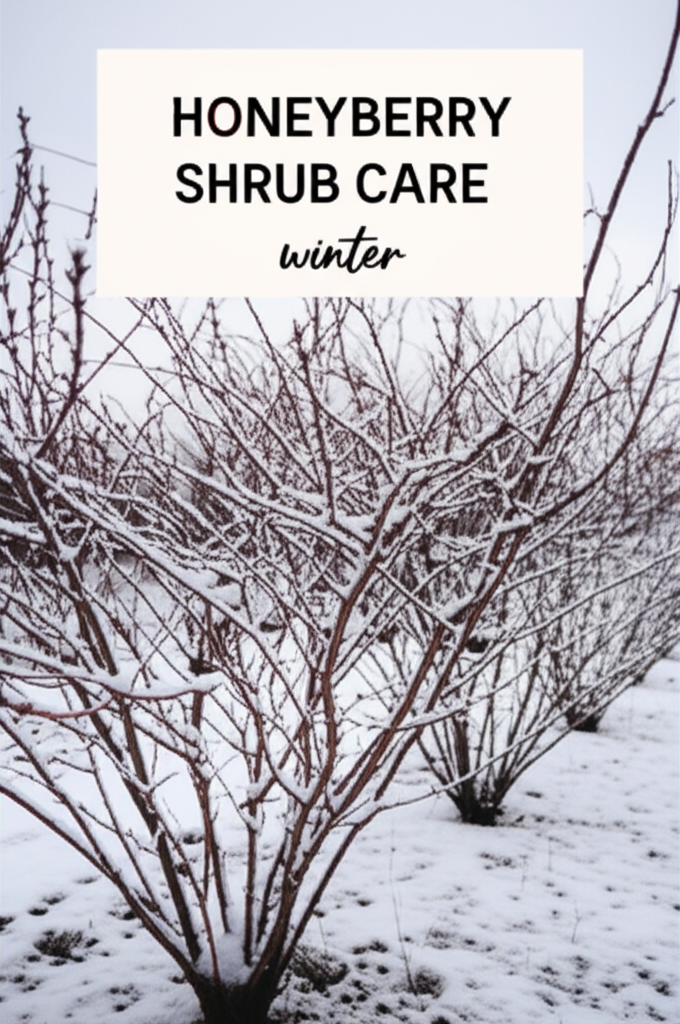Introduction: Embracing the Cold with Honeyberries
As winter descends, many gardeners focus on protecting their more tender perennial plants. However, the hardy honeyberry shrub (Lonicera caerulea), also known as haskap or edible honeysuckle, enters a period of crucial dormancy. Far from being neglected, this resilient native of the northern hemisphere thrives in cold weather, setting the stage for a bountiful spring and summer harvest. Understanding proper winter care for your honeyberry shrubs is key to ensuring their health, longevity, and productivity. This comprehensive guide will equip you with the knowledge to protect your honeyberries from winter’s challenges and prepare them for a vigorous growing season.
Why Winter Care Matters for Honeyberry Shrubs

While honeyberries are remarkably cold-hardy, their winter well-being is not entirely hands-off. Proper care during the dormant season impacts several critical aspects:
- Frost Protection: Even hardy plants can suffer damage from sudden temperature drops or prolonged exposure to extreme cold, especially when young or newly planted.
- Moisture Management: Winter can bring dry spells, and frozen ground can prevent moisture uptake, leading to desiccation.
- Pest and Disease Prevention: A healthy dormant plant is less susceptible to overwintering pests and diseases.
- Root Development: Protection during winter allows the root system to establish and strengthen without the added stress of harsh conditions.
- Future Fruiting: A well-cared-for shrub in winter will be stronger and produce more flowers and, consequently, more delicious berries in the growing season.
Key Honeyberry Facts in Winter
Before delving into care tips, let’s establish some fundamental knowledge about honeyberries during the winter months.
| Characteristic | Winter State/Requirement |
|---|---|
| Cold Hardiness | Extremely hardy, tolerating temperatures as low as -40°F (-40°C) or even lower depending on the cultivar. |
| Dormancy | Enters a state of true dormancy, ceasing active growth. This is essential for overwintering and future flowering. |
| Water Needs | Minimal. The ground should not be waterlogged. Focus on ensuring moisture is available if the ground isn’t completely frozen for extended periods. |
| Sunlight | Does not require sunlight during dormancy. The plant is photosynthesizing very little, if at all. |
| Pollination | Requires at least two different honeyberry cultivars planted within pollination distance (typically within 50-100 feet) for fruit production. This is a year-round consideration but crucial for the following season’s harvest. |
| Pruning | Best performed during the dormant season (late winter to early spring) before new growth begins. |
Pre-Winter Preparations: Setting the Stage for Success
The most critical phase of honeyberry winter care begins in the late autumn, before the first hard frost. Proactive measures will significantly enhance your shrubs’ ability to withstand winter’s trials.
1. Fall Fertilization (or Lack Thereof)
Avoid fertilizing your honeyberry shrubs in late autumn. Applying nitrogen-rich fertilizers too late in the season can stimulate new, tender growth that is highly susceptible to frost damage. If your plants showed signs of nutrient deficiency during the growing season, a light application of a balanced, slow-release fertilizer in early spring is more appropriate.
2. Watering Before the Freeze
As temperatures begin to drop and the ground starts to harden, ensure your honeyberry shrubs are adequately watered. A deep watering a week or two before the first hard freeze is beneficial. This helps the soil retain moisture and provides the roots with essential hydration as they prepare for dormancy. Avoid overwatering, as waterlogged soil can lead to root rot, especially in cold conditions.
3. Mulching for Protection and Moisture Retention
Applying a layer of organic mulch around the base of your honeyberry shrubs is one of the most effective winter care practices. A 2-3 inch layer of mulch will:
- Insulate the soil: This helps to maintain a more stable soil temperature, protecting the roots from extreme fluctuations.
- Conserve moisture: Mulch reduces water loss from the soil surface due to evaporation.
- Suppress weeds: While less active in winter, weed prevention is always beneficial.
- Prevent frost heave: Mulch can help prevent the ground from repeatedly freezing and thawing, which can push young plants out of the soil.
Good mulching materials include:
- Shredded bark
- Wood chips
- Straw
- Compost
Ensure the mulch is kept a few inches away from the main stem to prevent moisture buildup against the bark, which can encourage fungal diseases and pest infestations.
4. Protection for Young or Newly Planted Shrubs
While established honeyberry shrubs are exceptionally hardy, young plants (typically less than two years old) and those recently transplanted may benefit from extra protection.
- Burlap Wrap: For very young or vulnerable plants, you can wrap the entire shrub with burlap. This provides a physical barrier against windburn and extreme cold. Secure the burlap with stakes or twine.
- Tree Guards: Plastic tree guards can be placed around the base of young plants to protect the trunk from rodent damage and frost.
- Temporary Cover: In areas with particularly harsh winters or for exceptionally young plants, a temporary cover made from frost cloth or even an old blanket can be used during severe cold snaps. Remove these covers during mild, sunny days to allow for air circulation.
Winter Care Practices: Ongoing Management
Once winter has firmly set in, your primary focus shifts to monitoring and maintenance.
1. Monitor Moisture Levels (When Possible)
In regions with mild winters where the ground may not be consistently frozen, keep an eye on soil moisture. If there are extended dry periods without snow cover, and the ground is not frozen solid, a light watering might be necessary. This is rare, as snow cover typically provides adequate moisture.
2. Snow as Insulation
Snow is an excellent natural insulator. A blanket of snow around your honeyberry shrubs is beneficial, providing a consistent temperature buffer and protecting the plants from desiccating winds. Avoid piling snow directly against the stems in a way that could cause breakage when it melts or refreezes.
3. Rodent Protection
Winter can be a challenging time for rodents, and they may seek out the bark of young shrubs for food. Tree guards, as mentioned earlier, are very effective. If you notice signs of gnawing or burrowing around the base of your plants, consider using rodent repellents or traps in the surrounding area (following product instructions carefully).
4. Inspect for Damage
Periodically inspect your honeyberry shrubs throughout the winter for any signs of damage from pests, rodents, or extreme weather. Early detection allows for prompt intervention.
Late Winter / Early Spring Pruning: A Crucial Step
The best time to prune honeyberry shrubs is in late winter or very early spring, before new growth begins. This dormant pruning is essential for maintaining plant health, shape, and fruit production.
Pruning Objectives:
- Remove Dead, Damaged, or Diseased Wood: Cut out any branches that are clearly dead, broken, or show signs of disease.
- Improve Air Circulation: Thin out crossing or inward-growing branches to allow for better airflow within the shrub. This helps to reduce the risk of fungal diseases.
- Encourage Fruiting: Honeyberries produce fruit on the previous year’s growth. Pruning helps to encourage new, vigorous growth, which will bear fruit in the following season.
- Maintain Shape and Size: Prune to keep the shrub within desired dimensions and to maintain an open, productive structure.
Pruning Techniques:
- Cut back to a healthy bud or branch: Make clean cuts at a 45-degree angle, sloping away from the bud.
- Remove about one-third of the oldest stems each year: This encourages new basal growth, which is typically more productive.
- Avoid over-pruning: Honeyberries are naturally bushy. Over-pruning can reduce the number of fruiting spurs.
Seasonal Transition: From Dormancy to Growth
As winter begins to wane and the first signs of spring emerge, your honeyberry shrubs will soon awaken from their dormancy.
1. Removing Winter Protection
Once the threat of severe frost has passed, gradually remove any winter protection you applied. If you used burlap wraps or temporary covers, take them off to allow the plant to acclimatize to warmer temperatures and increasing sunlight.
2. Spring Fertilization (If Needed)
If your honeyberry plants showed signs of nutrient deficiency during the previous growing season, this is the time for a light application of a balanced, slow-release fertilizer. Alternatively, a top dressing of compost can provide essential nutrients.
3. Mulch Refreshment
As temperatures warm up, you may want to refresh or replenish your mulch layer. This will help conserve moisture as the plant begins its active growth phase and suppresses any early-emerging weeds.
Honeyberry Winter Care: Pros and Cons
Understanding the benefits and potential drawbacks of different winter care strategies can help you make informed decisions for your specific climate and garden.
| Practice/Strategy | Pros | Cons |
|---|---|---|
| Mulching | Insulates roots, conserves moisture, suppresses weeds, prevents frost heave. Highly effective. | Can harbor pests if too close to the stem; requires annual replenishment. |
| Watering Before Freeze | Ensures adequate hydration for roots entering dormancy. | Risk of overwatering if drainage is poor. |
| Burlap Wraps (for young plants) | Provides excellent protection against windburn and extreme cold for vulnerable plants. | Can be labor-intensive; needs to be removed in spring. May harbor moisture against the bark if not applied correctly. |
| Tree Guards | Protects young trunks from rodents and mechanical damage. | Primarily for trunk protection, not overall plant insulation. |
| Dormant Pruning | Removes deadwood, improves structure and airflow, encourages new growth and fruiting. Essential for long-term health. | Requires knowledge of proper pruning techniques to avoid damaging the plant or reducing yield. |
| Over-fertilization in Autumn | None | Stimulates tender new growth, making the plant susceptible to frost damage. Can lead to weaker plants. |
Common Mistakes to Avoid in Winter Honeyberry Care
Even with the best intentions, some common missteps can hinder your honeyberry shrubs’ winter survival and subsequent growth.
- Overwatering in Fall: Leading to soggy soil and potential root rot.
- Fertilizing Too Late in the Season: Encouraging tender new growth that will likely be killed by frost.
- Forgetting About Young Plants: Neglecting to provide extra protection for newly planted or very young shrubs.
- Pruning at the Wrong Time: Pruning too early in winter can remove dormant flower buds, and pruning too late in spring can result in significant sap loss and reduced vigor.
- Packing Mulch Against the Trunk: Creating a moist environment that can lead to disease and pest issues.
- Ignoring Rodent Activity: Allowing rodents to girdle young trunks, which can kill the plant.
Conclusion: A Rewarding Investment
Caring for your honeyberry shrubs during the winter is a straightforward yet vital process. By implementing these strategies – from pre-winter watering and mulching to appropriate pruning in late winter – you are investing in the health, resilience, and future productivity of your plants. These hardy, delicious berries are a testament to the power of nature’s resilience, and with a little attention during their dormant period, you’ll be rewarded with an abundant harvest of sweet, nutritious fruit year after year. Embrace the winter, and prepare for a truly delightful spring and summer with your thriving honeyberry bushes.


